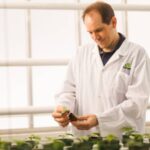Q&A With the Canadian Sphagnum Peat Moss Association
The Canadian Sphagnum Peat Moss Association (CSPMA) is an association of peat moss producers and related enterprises devoted to promoting the long-term health of the industry. Founded in 1988 to highlight the benefits of peat moss to horticulturists and home gardeners throughout North America, the CSPMA is made up of 18 peat moss producers and marketers, representing 95 percent of Canada's total production. In addition to promotional efforts, the CSPMA undertakes a proactive campaign on environmental issues.
Some are misinformed about the harvesting of peat moss, and the CSPMA is committed to providing the public accurate information on harvesting and environmental issues. Paul Short, CSPMA president, recently shared the association's mission and goals with Big Grower:
Many think that peat is overharvested, in part for its use in some European countries for fuel. What's the situation really like in North America?
Peatlands are resources subject to the same management practices and regulations that govern wise use of other sustainable natural resources. In Canada, peatlands cover around 279 million acres. To help put this into perspective, all the bogs in Canada would cover the four western states, and the size of the peat harvesting industry is less than the area covered by the city of Portland, Ore.
The total Canadian peat harvesting area used during the past 70 years is 42,000 acres. This equates to less than 1 acre in 6,000 being harvested.
A key measure of resource sustainability is the rate of harvest to natural ecosystems production. Within Canada, more than 70 million tons of peat accumulate each year. Of this the sphagnum peat moss industry harvests 1.3 million tons. (Source: Canadian Peat Harvesting and the Environment, second edition.)
Based on this information, the commercial use of sphagnum peat moss by the Canadian horticultural peat industry does not represent overharvesting. While Canada has 25 percent of the world's peatlands, the United Kingdom has only one quarter of one percent. The Canadian peat industry has as its policy to ensure that peatlands are conserved.
What is being done to improve peat's image?
CSPMA continues to promote sustainable management of peatlands. We provide an information source on many aspects of the harvesting, production, quality and value of peat use for consumers and professional growers. Educational brochures and specific "how-to" information are available by request through our offices.
We recently launched a new logo for sustainable peatland management and a national sign campaign to promote the awareness of our successes and commitment to restoration and reclamation of harvested bogs.
We are actively engaged in the creation of the Sustainable Agricultural Standard following the ANSI process within the United States. Internationally, we participate in the International Peat Society and are working cooperatively in understanding wise use and restoration practices pioneered by research partly sponsored by the industry through the Industrial Chair for Peatland Research at Universit Laval in Quebec City, Quebec.
Through this work we have perfected techniques for restoring peatlands back to functioning ecosystems within three to five years.
Is peat harvesting sustainable? What changes are you making in harvest procedures to make it more so?
The members of the CSPMA adhere to the Preservation and Reclamation Policy established by the association. This policy includes:
- identifying bogs for preservation.
- leaving buffer zones of original vegetation.
- leaving a layer of peat below harvesting levels to encourage rapid regrowth.
- returning harvested bogs either to functioning ecosystems, for- ests, wildlife habitats or agricul- tural production areas.
The industry has committed to a restoration program that returns the peatlands to functioning wetland ecosystems. We recognize that peatland functions provide water storage and filtration, support flora and fauna biodiversity, and act as carbon storage sites.
The results of the research are significantly changing the practices of not only Canadian peat companies but have been introduced throughout the world through the work of the Industrial Chair, Dr. Line Rochefort. The Peat Ecological Research Group (www.gret-perg.ulaval.ca) is an excellent source for information on restoration.
The CSPMA also engages with research programs that examine the natural disturbance regimes from wildfires and permafrost melting as they relate to natural peatlands. Climate change research and emissions management are also key research areas we engage in through discussions with national research agencies (Canadian Forest Service, Northern Research Center) and others. The emerging emissions trading programs and the international negotiations for climate change are also monitored.
Are you working with a third-party association to certify your practices or review your procedures?
Many of the companies have ISO certification that govern their manufacturing practices.
The CSPMA is examining sustainability accounting and evaluating the potential of establishing sustainable peatland standards and certification systems. The industry recently held a workshop, under the guidance of a consulting firm, to examine the impacts, establish priorities, create a draft plan and explore implementation strategies.
The CSPMA is also taking a lead role in the International Peat Society in their efforts to create an international certification for Sustainable Peatland Management.
SIDEBAR
The Bog Restoration Process
The following text was taken from the recently published Restoration Brochure.
Copies are available upon request through the CSPMA.
Harvesting can take place for up to 30 years on the same bog. Many of the bogs are 15-20 feet deep; operators remove 2-3 inches of depth per year. According to the CSPMA Preservation and Reclamation Policy, a layer of peat about 3 feet thick is to be left when harvesting ends.
Replant. The harvesting cycle continues, even after harvesting has stopped. The next step is to level the bog, and spread sphagnum fragments onto the site. Those fragments are either collected when opening a new bog or gathered from the top 6 inches of a natural bog (also known as the donor site). The fragments contain seeds or spores from all the natural bog plants, not just the sphagnum moss. The material is then covered by a straw mulch to keep the moisture in. The donor site will regrow within two years.
Rewet. After the fragments have been covered with straw, the main ditch around the bog is dammed so that the water table can rise to its original depth (about 8-10 inches below the surface).
Regrow. Regrowth starts in the first two years after the fragments have been spread. Although there is little sign of sphagnum regrowth, at this stage the field turns green with live plants. Usually three to five years after planting, sphagnum and many of the other bog plants such as pitcher plants, sundew, Labrador tea, bog rosemary and some swamp spruce start to appear.
Restore. Within five years, the sphagnum has accumulated 4-8 inches in depth, the pitcher plants are fully developed and birds, animals and amphibians have started to return to the bog. It is at this stage of the cycle that the bog begins to return to a functioning peatland ecosystem.


 Video Library
Video Library 




















